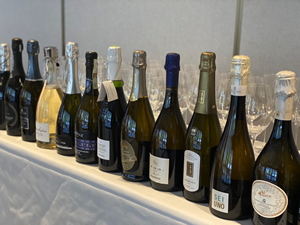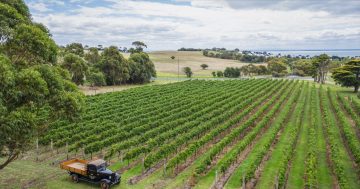By Christine Salins.

Tasting line-up of Conegliano Valdobbiadene Prosecco Superiore DOCG wines
Prosecco accounts for a third of the world’s sparkling wine production, and the volume being produced is growing by the day. By the minute even.
About 500 million bottles from Italy’s vast Prosecco DOC are sold annually, along with about 100 million bottles from the more exclusive Prosecco DOCG.
Italy’s sparkling wine production is forecast to hit one billion bottles annually by 2024, and you can bet a lot of that will be Prosecco.
It’s fair to say that the world has fallen in love with this bright and lively wine. Little wonder, for it is at once easy-drinking yet sophisticated, food-friendly yet the perfect aperitif, a refreshing pick-me-up and a celebration drink.
Made predominantly from the glera grape variety, the bubbles are mostly produced by the charmat method of secondary fermentation in a tank, rather than the méthode traditionelle used to make Champagne where the secondary fermentation is in the bottle.
The designated production zone (DOC) for Prosecco is a sub-alpine region in north-east Italy, in the Veneto and Friuli regions.
Conegliano Valdobbiadene, a sub-zone of this DOC, is Prosecco’s highest classification. Around 50km north of Venice and 100km from the Dolomites, it’s a beautiful part of the world, recognized as a UNESCO World Heritage site, and high on my wish list of places I want to visit when the world returns to normal.
Last month, Tyson Stelzer conducted trade and media tastings in Australia on behalf of the Consorzio Conegliano Valdobbiadene Prosecco Superiore DOCG. Stelzer is recognized more for his knowledge of Champagne than Prosecco, but earlier this year he happily lined up 70 bottles of Prosecco sent to him by the Consorzio for tasting.
He whittled those down to 17 to show, exemplifying a diversity of styles and spanning sweetnesses from brut nature and extra brut to brut, extra dry and dry. Seven of these wonderful Conegliano Valdobbiadene Prosecco Superiore DOCG wines are currently available in Australia:
Andreola Brut Dirupo NV: Beautifully refreshing, perfect for a summer aperitif with just a hint of sweetness (10g residual sugar).
Le Colture Extra Dry Pianer NV: Different from any Prosecco you might be used to, with a ‘wild’ flavour, crisp citrus notes and pungent aroma. (14g residual sugar)
Bellenda Extra Brut Rive di Carpesica Metodo Classico Sei Uno 2018: This one actually undergoes a secondary fermentation in bottle (for a year). It’s also put into barrels for a few months prior to bottling, resulting in a smooth, creamy, gentle wine with less emphasis on fruitiness and a little more texture, savouriness and complexity. A huge tick to this one.
Borgoluce Brut NV: This vineyard is in biodynamic conversion though not yet certified. Very pale in colour with enticing aromatics and a hint of sweetness (7g residual sugar).
Mongarda Brut 2020: From an organic vineyard, with wild yeast used for primary fermentation. Very dry and a little flinty with honey and citrus notes (2.3g residual sugar).
Salatin Extra Dry Millesimato 2020: Elegant and rather soft, with apple and rose notes and a deliciously persistent mousse, 13-15g residual sugar.
Ruggeri Extra Dry Giustino B. 2020: A lot of Prosecco has been planted in recent years but the vines for this one are up to 110 years old, making it quite a treasure. Delicate, refined and harmonious. The perfect wine to celebrate with. (17g residual sugar)




